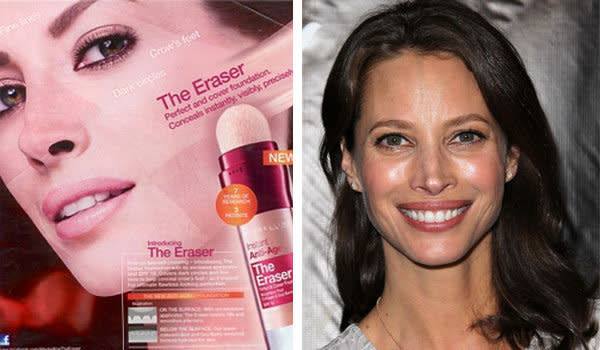 Yahoo Lifestyle
Yahoo LifestyleL’Oreal’s airbrushing ads banned
Make up campaigns featuring Julia Roberts and model Christy Turlington have been banned by the Advertising Standards Agency for misleading the public.
Liberal Democrat MP Jo Swindon complained to The ASA that the ads put pressure on women and young girls who compare themselves unfavorably to the unrealistic images.
Swindon’s complaint comes after research by cosmetic company Transform Cosmetic Surgery found four in ten women spend an average of £20-50 a month on anti-wrinkle creams, although 45% said they were unhappy with the results.
[See also: Victoria's Secret airbrushing mistakes]
The ASA upheld Jo Swindon’s complaint that the glossy magazine ad was confusing and it exaggerated the effects of the product.

As the face of Lancôme, one of L’Oreal’s make up brands, Julia Roberts is shown in a two-page magazine spread promoting the Teint Miracle Foundation that claims to ‘recreate the aura of perfect skin’.
L’Oreal has acknowledged the use of ‘post production’ techniques on the image of the actress but remained firm that the picture was an accurate representation of her ‘naturally healthy and glowing skin’.
Their defense continued: ‘On the basis of the evidence we had received we could not conclude that the ad image accurately illustrated what effect the product could achieve, and that the image had not been exaggerated by digital post production techniques.’
The French cosmetic brand was also under fire for another deceptive image in a Maybelline ad featuring model Christy Turlington.

The Eraser foundation image appears to cover parts of her face with the foundation while other areas are left natural to show the effects on the skin. It highlights the benefits across the ad: ‘Conceals instantly, visibly, precisely… covers dark circles and fine line to help conceal crow’s feet – as if erased!’
Additional text accompanied the product at the bottom admitting the image was an ‘Illustrated effect.’
L’Oreal again admitted Turlington’s features had been enhanced in the image to ‘lighten the skin, clean up make-up, reduce dark shadows and shading around the eyes, smooth the lips and darken the eyebrows’ but insisted that the image was an accurate representation of the benefits of the foundation.
This is the second time the beauty company has been in hot water for faking images. Back in 2009 an Olay advert for anti-ageing featuring Twiggy was banned.
Using photo manipulation in make up ads has been a long-running debate in fashion and beauty industries and has come under particular focus after a series of recent flubs.
High street retailers Topshop recently replaced an image of a model on their website after she was dubbed ‘too skinny’ and H&M made the mistake of airbrushing out the face of a model in an image that showed reverse angles.

The face of beauty, confidence and success
How to apply bronzer
Eat yourself beautiful

